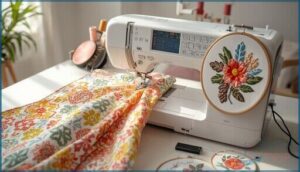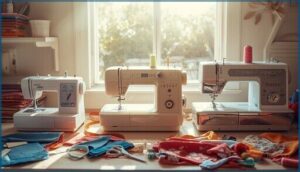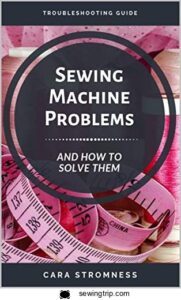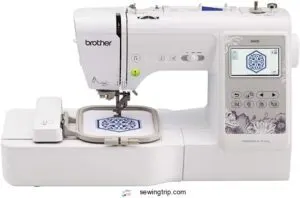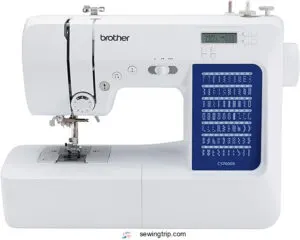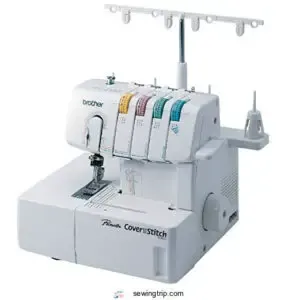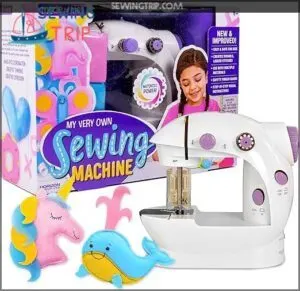This site is supported by our readers. We may earn a commission, at no cost to you, if you purchase through links.
I bought my first sewing machine at a thrift store for twelve dollars—a clunky beige Singer that jammed every third stitch and made sounds like a distressed vacuum cleaner. But that temperamental machine taught me something textbooks couldn’t: real sewing skills come from wrestling with tension dials at midnight, rethreading the same stubborn needle five times, and refusing to quit when your bobbin case shoots across the room.
My sewing machine journey hasn’t been a smooth, straight seam—it’s been more like gathering fabric, with unexpected puckers and moments where everything finally clicks into place. Each machine I’ve owned, from that cranky Singer to my current computerized setup, has shaped how I create and what I believe is possible with thread and determination.
Table Of Contents
- Key Takeaways
- How I Began My Sewing Machine Journey
- Exploring Different Types of Sewing Machines
- Choosing The Right Sewing Machine for Each Stage
- Essential Skills and Maintenance Along The Way
- Top 5 Tools That Shaped My Sewing Journey
- Joining The Sewing Community and Sharing Experiences
- Frequently Asked Questions (FAQs)
- Conclusion
Key Takeaways
- Real sewing mastery comes from hands-on problem-solving with imperfect machines—wrestling with tension dials, threading stubborn needles, and refusing to quit—not from textbooks or fancy equipment.
- Your sewing machine journey should match your skill level and needs: beginners need reliable basics like automatic threading and adjustable speed, while advanced sewists benefit from specialized tools like sergers, coverstitchers, and embroidery machines that unlock new techniques.
- Regular maintenance habits—weekly lint cleaning, oiling every 8-10 hours, matching needles to fabrics, and basic troubleshooting skills—prevent most common machine problems and build real confidence.
- Connecting with sewing communities through online forums, sharing projects, and encouraging beginners transforms solitary craft into collaborative learning that accelerates your skills and keeps you inspired.
How I Began My Sewing Machine Journey
I picked up my first sewing machine as a teenager, and honestly, I’d no idea it would turn into something I’d still be doing over 20 years later. Those early high school classes gave me more than just basic skills—they handed me a way to rebel against mass-produced everything and create things that were truly mine.
Twenty years later, that teenage sewing class still fuels my rebellion against mass-produced everything
Looking back, three moments really stand out as the foundation of everything I know now.
Early Inspiration and Learning Experiences
Your sewing journey probably started like mine—someone handed you fabric and thread before you even knew what a bobbin was. Maybe a parent showed you how to mend a hem, or a 4-H leader guided your first wobbly seam.
Those early moments sparked something. Sewing basics became creative expression, and suddenly you weren’t just learning machine operation—you were discovering freedom through fabric selection and pure beginner curiosity. As your skills grew, you probably started exploring techniques like seam finishing with overlock to give your projects that polished, professional edge.
First Sewing Machine Memories
I remember my first treadle machine—heavy metal, foot pedal that demanded respect. My hands shook as I fed scrap cotton under the presser foot, watching wobbly seams appear like magic. Here’s what made those early days unforgettable:
- Threading that needle felt like solving a puzzle blindfolded
- The foot pedal’s rhythm became my creative heartbeat
- Fabric choices transformed from overwhelming to invigorating
- Each childhood project proved I could build something real
That tactile connection hooked me forever.
Discovering Sewing as a Creative Outlet
Once patterns and fabrics became your playground, sewing transforms into pure Creative Expression—not just stitching seams. Choosing colors felt like Textile Design therapy, while each stitch became Sewing Meditation that quieted my racing thoughts. When I finally learned the proper threading sequence with a comprehensive serger thread guide, my fabric edges transformed from frayed messes into clean, professional finishes.
Studies back this up: crafting genuinely lowers stress and boosts mood. Whether you’re piecing together a memory quilt or stitching canvas totes, a sewing machine with a large sewing area makes those therapeutic crafting sessions far more enjoyable.
Your Sewing Journey turns fabric into wearable art, proving you can shape both cloth and confidence with your own hands.
Exploring Different Types of Sewing Machines
Once I got comfortable with the basics, I couldn’t stop wondering what else was out there. The sewing machine world turned out to be way bigger than I’d imagined, with specialized tools for jobs I didn’t even know existed. One thing I learned pretty quickly: even the coolest machine won’t help much if you don’t know how to troubleshoot common mechanical sewing machine issues when they pop up.
Here’s how I branched out and tried machines that completely changed what I thought was possible. One of the biggest breakthroughs came when I finally understood thread tension adjustment tips and stopped battling my machine on every project.
Transitioning From Mechanical to Computerized Models
When you’re ready for machine upgrades, computerized models enable sewing automation that feels like magic. Built‑in stitch programs let you store custom patterns, and automatic needle threading plus thread tension sensing mean you’ll spend less time on sewing machine troubleshooting.
USB ports and on‑screen editing bring digital embroidery within reach. Electronic controls deliver quieter operation, and firmware updates keep your computerized stitching fresh without buying new gear.
Trying Sergers, Overlockers, and Coverstitch Machines
Once you’ve conquered computerized stitching, sergers and overlockers open a new door to professional fabric finishing. Serging trims edges and wraps seams in one pass, boosting sewing efficiency like nothing else.
Coverstitch benefits shine on knit hems—those parallel rows look store‑bought.
Threading multiple loopers feels tricky at first, but mastering serger tips means you’ll handle stretchy fabrics with confidence and speed.
Experimenting With Quilting and Embroidery Machines
Quilting techniques and machine embroidery felt like sewing on steroids. My first quilting machine had a massive throat—room enough to wrestle bulky layers without cursing. Embroidery hoops and those built-in embroidery designs made creating custom patches ridiculously fun.
- Walking feet tamed fabric shifting during dense quilt assembly
- USB ports let you import wild embroidery designs you find online
- Thread management became critical—rayon threads need gentle tension tweaks
- Machine upgrades and add-on modules expanded my fabric selection possibilities
Choosing The Right Sewing Machine for Each Stage
Finding the right machine at each stage of your sewing journey can feel like traversing a maze blindfolded. I’ve spent years figuring out what actually matters when you’re choosing a machine, and I’ve made plenty of mistakes along the way.
Here’s what I wish someone had told me about matching your machine to where you’re right now.
Key Features I Searched for as a Beginner
When you’re choosing the right sewing machine as a beginner, don’t let fancy bells and whistles fool you. I zeroed in on machine basics that actually mattered—automatic needle threaders saved my sanity, and adjustable sewing speed let me crawl before I could sprint.
Here’s what I prioritized for sewing for beginners:
| Feature | Why It Mattered |
|---|---|
| Thread Control | Prevented tangled messes |
| Clear User Interface | No guessing games |
| Fabric Compatibility | Handled cotton to denim |
| LED Lighting | Saw every stitch clearly |
Those sewing machine features transformed frustration into confidence.
Balancing Budget and Performance
You’ll face a real trade-off: entry-level machines run $100–$300 with solid stitches, while computerized models over $500 bring auto-threading but steeper costs.
I learned cost analysis means factoring in thread, needles, and service—about 10–20% yearly.
My budget planning? Nail reliability and stitch quality first, skip the embroidery extras. That’s value optimization for actual performance metrics.
Lessons Learned From Upgrading Machines
When you upgrade your sewing machine, you’ll see double-digit drops in skipped stitches—real stitch quality gains across fabrics. Moving from mechanical to computerized means better fabric compatibility and auto-tension.
Maintenance tips? Newer models give self-cleaning bobbin areas and oiling reminders.
Reading sewing machine reviews before your upgrade reveals these benefits: easier threading, faster machine repair, and smarter sewing machine selection.
Essential Skills and Maintenance Along The Way
Owning a sewing machine is one thing, but keeping it running smoothly is where the real confidence comes in. I learned early on that a little know-how goes a long way when things go wrong or your stitches start looking wonky.
Here are the essential skills and maintenance habits that kept my machines humming through every project.
Troubleshooting Common Sewing Machine Issues
When your machine starts acting up, don’t panic—most problems are easier than you think. Thread tension issues and bobbin jams were my biggest headaches early on.
I learned that skipped stitches usually mean you need a fresh needle, while loops underneath signal bobbin trouble. Understanding basic troubleshooting transformed my frustration into confidence.
You’ll catch on fast once you tackle your first real problem.
Regular Cleaning and Oiling Practices
Once you’ve figured out those pesky problems, keep them from coming back with solid cleaning and oiling practices. I wipe my bobbin area weekly with a lint brush and apply quality machine oil every 8–10 hours of stitching.
Proper sewing machine lubrication prevents thread tension headaches and keeps your maintenance routines simple. Trust me—a clean machine equals stress-free sewing.
Matching Needles and Fabrics for Best Results
Clean gear only takes you so far—your fabric selection and needle types make or break stitch quality. Here’s what I’ve learned about thread compatibility and fabric weight:
- Use ballpoint needles for knits to prevent snags and runs.
- Switch to sharp (microtex) needles for silk and delicate weaves.
- Match universal 80/12 needles with cotton and linen.
- Upgrade to 90-110 sizes for denim and canvas.
- Replace sewing needles every 8–12 hours of use.
These sewing tips and tricks transformed my thread tension struggles into smooth sailing.
Top 5 Tools That Shaped My Sewing Journey
Looking back, I realize my growth as a sewist wasn’t just about skills—it was about the machines and tools that met me at each stage. Some became trusty workhorses, while others opened doors I didn’t even know existed.
Here are the five game-changers that truly shaped my journey from fumbling beginner to confident creator.
1. Sewing Machine Troubleshooting Guide
When skipped stitches drove me crazy at 2 a.m., a $2.99 troubleshooting guide became my lifeline. This 82-page resource walks you through needle problems, thread tension, and bobbin issues without fancy jargon.
Sure, it lacks photos and repeats some advice, but it taught me how machine timing affects stitch quality and when to check my feed dogs. You’ll save money fixing things yourself instead of running to a repair shop.
Best part? The step-by-step sewing machine maintenance tips work whether you’re wrestling with vintage machines or modern computerized models.
| Best For | Home sewers who want to fix common machine problems themselves without paying for professional repairs. |
|---|---|
| Price Range | $2.99 |
| Skill Level | All levels |
| Primary Use | Troubleshooting reference |
| Product Type | Guide book |
| Portability | Highly portable |
| Threading System | N/A |
| Additional Features |
|
- Covers over 20 common issues with practical solutions that work on both old and new machines
- Costs less than $3, which pays for itself after avoiding just one repair visit
- Explains timing, tension, and needle problems in plain language that beginners can follow
- No photos or diagrams make it harder to visualize what you’re supposed to do
- The index isn’t accurate, so finding specific problems takes extra time
- Repeats the same advice for different issues instead of offering unique solutions
2. Brother Sewing And Embroidery Machine
Once you’ve mastered basic troubleshooting, you’re ready for a machine that does more than straight stitches. The Brother SE600 changed everything for me—103 built-in sewing stitches plus 80 embroidery designs on a 3.2″ touchscreen. You get automatic needle threading and a 4″ x 4″ embroidery field that accommodates custom designs.
Sure, it weighs 26 pounds and won’t fit tight spaces, but machine embroidery became accessible without breaking the bank. Thread management matters here—cheap thread will jam that beautiful drop-in bobbin fast.
| Best For | Sewers and embroiderers who want to expand beyond basic stitching into custom embroidery projects without spending thousands on professional equipment. |
|---|---|
| Price Range | $399-$499 |
| Skill Level | Beginner to experienced |
| Primary Use | Sewing and embroidery |
| Product Type | Sewing/embroidery machine |
| Portability | Limited (26.2 lbs) |
| Threading System | Automatic needle threader |
| Additional Features |
|
- 103 sewing stitches and 80 embroidery designs give you tons of creative options, plus you can import custom designs through USB
- Automatic needle threader and drop-in bobbin system make setup way less frustrating than older machines
- 3.2″ color touchscreen makes selecting and editing designs straightforward, even if you’re new to embroidery
- At 26 pounds and over 21 inches wide, it takes up serious counter space and isn’t easy to move around
- 4″ x 4″ embroidery area limits you to smaller designs—you can’t do full jacket backs or large quilt blocks
- Needs regular cleaning and maintenance, and cheap thread will jam the system fast
3. Brother Computerized Sewing Machine
When I upgraded to the Brother CS6000i, I discovered what true computerized features could do—60 built-in stitch options, automatic needle threading, and sewing speed up to 850 stitches per minute. Machine comparison taught me that not all computerized models equal performance. The CS6000i’s LCD display made stitch selection dead simple compared to my old Brother XL2600i.
Maintenance tips stayed consistent: clean the feed dogs every few projects. This sewing machine bridged the gap between basic mechanical models and premium options like the Brother SE400 without emptying my wallet.
| Best For | Sewers who want a reliable computerized machine with plenty of stitch options and beginner-friendly features without spending a fortune. |
|---|---|
| Price Range | $199-$249 |
| Skill Level | Beginner to experienced |
| Primary Use | Sewing and quilting |
| Product Type | Sewing machine |
| Portability | Portable (14 lbs) |
| Threading System | Automatic needle threader |
| Additional Features |
|
- 70 built-in stitches and 7 buttonhole styles give you tons of creative options for any project
- Automatic needle threader and drop-in bobbin save time and cut down on frustration
- Wide table and large workspace make quilting and bigger projects way easier to handle
- Automatic needle threader can be finicky and takes some practice to get right
- Only comes with one bobbin, so you’ll need to buy extras right away
- Some plastic parts might not hold up as well as metal ones over heavy use
4. Brother Cover Stitch Serger Machine
Knit fabrics used to intimidate me until I grabbed the Brother 2340CV cover stitch serger machine. This beast manages stretch material like a champ—tri-cover stitch, narrow and wide options, differential feed from 0.7 to 2.0 millimeters.
Professional hems on T-shirts? Done. Chain stitching for decorative edges? Easy. Sure, some users report thread breakage, but proper tension adjustment solved that for me.
At 1,100 stitches per minute, it’s faster than my Brother CS6000i and complements any sewing machine arsenal when you’re ready to conquer knits.
| Best For | Sewists who work frequently with knit and stretch fabrics and want professional-looking hems, decorative stitching, and cover stitch finishes without the bulk. |
|---|---|
| Price Range | $249-$299 |
| Skill Level | Intermediate |
| Primary Use | Cover stitching stretch fabrics |
| Product Type | Cover stitch machine |
| Portability | Moderate (15x14x12.9 in) |
| Threading System | Color-coded threading |
| Additional Features |
|
- Fast stitching speed at 1,100 stitches per minute with versatile 2-3-4 cover stitch functions for different fabric weights
- Differential feed (0.7-2.0mm) and color-coded threading make it easier to handle stretchy materials without puckering
- Creates professional chain stitching and decorative topstitching for garments like T-shirts, swimsuits, and activewear
- Multiple users report thread breakage and skipped stitches that require careful tension adjustment to fix
- Quality control issues in manufacturing may lead to inconsistent performance out of the box
- Not ideal for advanced sewists who need more complex features beyond basic cover stitch functions
5. Made By Me Sewing Machine For Kids
Teaching my niece to sew sparked my search for kid-friendly machines, and the Made By Me sewing machine for kids delivered. This portable sewing machine model runs on four AA batteries—perfect for beginners ages eight and up.
Two speeds, pre-threaded bobbins, and finger guards keep sewing safety front and center. The included sewing kit has fabric, thread, and stuffing for kids’ sewing projects like pillows or toys.
Some youth education setups report jamming issues, but proper machine maintenance and adult supervision help. It’s not built for heavy use, yet it ignites creativity in young sewists.
| Best For | Parents or teachers looking for a safe, battery-powered starter sewing machine to introduce kids ages 8 and up to basic sewing skills and creative projects. |
|---|---|
| Price Range | $29.99 |
| Skill Level | Beginner (ages 8+) |
| Primary Use | Learning to sew |
| Product Type | Kids sewing machine |
| Portability | Highly portable (2.41 lbs) |
| Threading System | Pre-threaded bobbins |
| Additional Features |
|
- Two-speed operation with adjustable stitches and pre-threaded bobbins makes learning easier for beginners
- Built-in finger guards and slower needle speeds prioritize safety during use
- Portable, battery-powered design (4 AA batteries) with complete starter kit including fabric, thread, and stuffing
- Thread can get caught or cut, and the machine is prone to jamming with frequent use
- Limited durability means it’s not suitable for heavy or long-term sewing projects
- Instructions may be unclear, and younger children under 8 will need significant adult supervision
Joining The Sewing Community and Sharing Experiences
Sewing solo gets old fast. Once I started connecting with other makers online and in person, everything changed—I picked up tricks I never would’ve found on my own, gained confidence from sharing my wonky early projects, and discovered how much I loved cheering others on.
Here’s how tapping into the sewing community turned my craft from a quiet hobby into something way more rewarding.
Finding Inspiration From Online Forums and Classes
You’ll find endless creative fuel when you dive into online tutorials and sewing communities. Forums buzz with thousands of active sewists sharing project ideas and troubleshooting tips that’ll spark your next creation.
Online sewing classes break down complex sewing techniques into manageable chunks you can replay anytime. Class reviews and forum engagement give you real feedback on what works—turning inspiration into actual sewing project ideas you can confidently tackle.
Sharing Projects and Advice With Fellow Sewists
Posting your finished piece on Facebook groups or Instagram under #sewingcommunity connects you with millions of fellow creators who genuinely want to see what you’ve made. You’ll get specific project feedback that sharpens your skills—around 60-70% positive reinforcement plus actionable tips on sewing techniques that stuck with me more than any formal class ever did.
Try these powerful ways to engage with sewing communities:
- Share photo tutorials with step-by-step captions for online tutorials that others bookmark and revisit
- Join monthly sewing challenges that push you toward new sewing project ideas you wouldn’t try alone
- Post troubleshooting solutions that help beginners avoid your past mistakes
- Swap fabric recommendations and needle advice in real-time collaborative learning sessions
- Celebrate finished sewing projects with honest material lists so others can recreate your work
When you drop a time-lapse video showing how you tackled a tricky seam, you’re not just showing off—you’re building sewing inspiration that ripples through the whole community.
Encouraging Others to Start Their Own Sewing Journey
You’ve got the power to ignite someone’s sewing journey—and that impact matters more than you think. When you invite a friend to try a beginner project or share sewing benefits like cost savings on repairs, you’re offering creative freedom they didn’t know they could claim.
Community support and sewing motivation spark faster progress than solo practice, so pass along your favorite sewing techniques and tips without holding back. Your sewing inspiration becomes their beginner confidence.
Frequently Asked Questions (FAQs)
What is the best sewing machine for a beginner?
Home sewing machine sales jumped 40% in 2020, showing newfound interest. You want a lightweight machine like the Brother SE400 with automatic needle threading, strong stitch quality, and budget-friendly pricing under $
How do I properly store my sewing machine to prevent damage?
Keep your sewing machine in a stable, dry space with 40–60% humidity. Use a dust cover, unplug it, and wipe surfaces with a microfiber cloth.
Regular maintenance routines prevent rust and damage.
What are the best materials to use for sewing beginners?
Start with cotton fabrics in light to medium weights—they’re forgiving and easy to handle.
Grab universal needles, 50-weight beginner threads, and sharp scissors. Natural fibers won’t betray you while you’re learning.
How can I improve my sewing skills quickly?
Set a daily practice routine, dive into sewing tutorials, and join a sewing community. Master stitch techniques through fabric selection and speed control.
Tackle beginner sewing projects, then push toward sophisticated sewing techniques for true mastery.
What are some common mistakes to avoid when sewing?
Ignoring fabric grain throws off your drape. Skipping pre-wash risks shrinkage.
Wrong needles damage textiles. Poor thread tension creates loops. Rush through pinning, and seams won’t align—every step matters for stitch quality.
What fabric types work best for beginners?
Cotton fabrics reign top for beginners—they’re forgiving, stable, and affordable. Linen blends, medium-weight denim, and polyester synthetics follow close behind. Jersey knits teach you stretch handling without the drama of slippery silks.
How do I prevent thread tension problems?
You’ll conquer thread tension by matching your needle to fabric weight, threading carefully through tension discs, checking bobbin settings, and cleaning lint buildup—these simple adjustments give you rock-solid stitch quality every time.
Can I sew leather with a standard machine?
You can totally sew thin leather on a standard machine if you grab a heavy-duty leather needle and adjust your stitch length—but thick stuff? That’s walking foot territory, my friend.
Whats the difference between needles for different fabrics?
You’ll want ballpoint needles for knits to prevent snags, sharp needles for wovens like cotton, and microtex for delicates. Match needle size to fabric weight—heavier fabrics need larger needles.
How often should I replace sewing machine needles?
Something so small can wreck everything—yet most of us forget needles exist.
Replace yours every 8–10 hours of sewing or with each new project to protect fabric, maintain stitch quality, and keep your machine happy.
Conclusion
Last month, a student showed me her first finished dress—sewn on a wobbly machine she’d rescued from her grandmother’s attic. Her hands shook with pride, not excellence.
That’s what my sewing machine journey taught me: confidence doesn’t arrive with expensive equipment or impeccable stitches. It builds through every tangled thread you fix, every zipper you conquer, every moment you choose creation over doubt.
Your machine isn’t just tools and metal—it’s your partner in becoming unstoppable.




